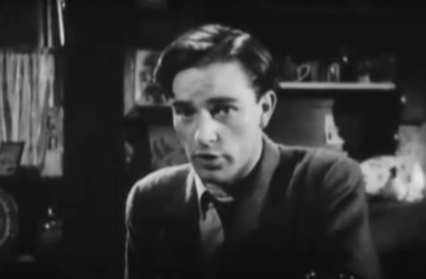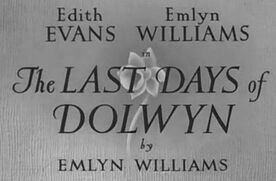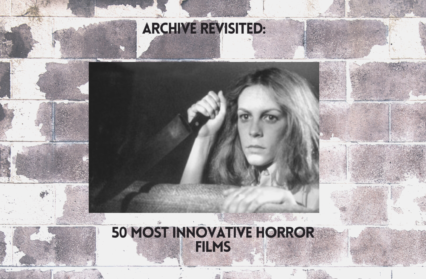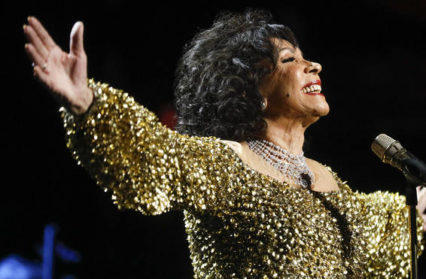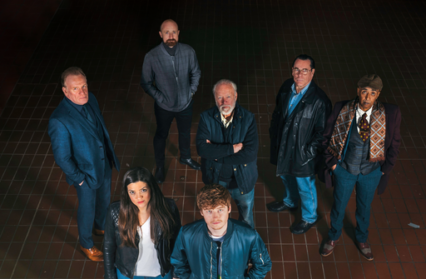The ‘Becoming Richard Burton’ / ‘Bywyd Richard Burton’ exhibition is now reopened at the National Museum Wales and Wales Arts Review is publishing a series of essays to run concurrently with the exhibition, curated by Daniel G. Williams, director of the Richard Burton Centre at Swansea University. Each essay will discuss a specific Burton film; this week, Dr Gwenno Ffrancon takes a look at Burton’s screen debut, Emlyn Williams’ The Last Days of Dolwyn.
The Last Days of Dolwyn, written and directed by Emlyn Williams, was screened for the first time at the Bangor Plaza Cinema on 27 April 1949. The premiere was attended by dignitaries including Prime Minister Clement Attlee, Lady Megan Lloyd George and Henry McLaren, the Second Baron Aberconway. They were all, including Williams, due to receive honorary awards from the University of Wales, Bangor the following day. The film was released to the rest of the United Kingdom in July 1949 and made its first appearance in America the following August under the title Woman of Dolwyn.
This may be a surprising and less than glamorous launch into the world for the film but it was entirely in keeping with the nature of the project and of Emlyn Williams’s vision of a work firmly rooted in his native north Wales. Emlyn Williams, born Emlyn George Williams in Rhewl Fawr, Flintshire in 1905, had garnered quite a reputation as an accomplished writer and actor by the mid-1940s. The film producer and owner of British Lion, Alexander Korda, had identified Williams, and co-actors Ralph Richardson and Robert Donat, as potential saviours of the struggling production company. The three were invited to direct a film each and given £50,000 apiece with access to the studio’s best technicians and actors to complete their projects. Williams was partnered with another Welshman, Russell Lloyd, born in Sketty, Swansea in 1916, to deliver his film. The pair soon agreed that Williams would draft the script and direct the actors whilst Lloyd, a talented editor and associate director, took on the responsibility of setting up, filming and directing each scene. The concept for the film, however, was solely Emlyn Williams’s vision.
The film is a melodramatic homage to the rural Welsh-speaking community of Williams’s childhood. In the tradition of the Welsh intelligentsia of the late nineteenth century and their endeavours to strengthen Welsh national identity through positive portrayals of the Welsh-speaking, literate, devout inhabitants of rural Wales, Williams romanticised the Welsh gwerin in his film, as he had done in his stage work The Corn is Green. The film depicts the peaceful idyllic life of the rural village of Dolwyn as it is shattered by the news that Lord Lancashire intends to drown the valley in order to provide drinking water for the communities of northern England. Lord Lancashire’s agent, Rob Davies (played by Williams himself), persuades the villagers that life in Liverpool would be an improvement for them, and Lady Dolwyn finds a solution to her money worries in selling and moving on. Everyone is satisfied with the proposal, apart from Merri, the chapel caretaker, and her foster son, Gareth. During the course of the film, Gareth finds a document in Merri’s possession showing that she is the owner of her cottage and that she cannot be forced to leave as would be the case for all other villagers. Merri succeeds in persuading Lord Lancashire – who has not been made fully aware by his agent of the impact of his dam on Dolwyn – that her home and village is worth saving from the deluge and secures his agreement that the water should be diverted, and the village saved, much to the delight of the villagers. Events from then on, however, and as befitting a melodrama, are not played out as might be expected.
Emlyn Williams relished the opportunity to depict his home country on screen, and fought and won the argument with the formidable Korda to include Welsh-language dialogue between the villagers of Dolwyn. He took the film’s cast and crew to Meirionnydd to complete the filming, choosing the village of Rhydymain as his reincarnation of Dolwyn. He cast several fellow Welshmen to key roles, including Hugh Griffith, Kenneth Evans, Madoline Thomas, Roddy Hughes and his young protégé, Richard Burton. Williams had been the one to offer the nineteen-year-old Richard Burton his first stage role in his stage-play The Druid’s Rest in 1944 and had encouraged him to screen test for the role of Gareth in The Last Days of Dolwyn. Williams informed the young actor of his success with a telegrammed line ‘you have won the scholarship!’, lifted from his own play The Corn is Green (1938). Burton had of course in 1945 played the part of Morgan Evans, the young miner turned scholar destined to succeed at Oxford due to Miss Moffat’s tutelage, in a BBC radio production of the play adapted by T. Rowland Hughes and produced by Philip P. Burton, Richard’s mentor. Richard Burton’s appearance in The Last Days of Dolwyn, it could be argued, emulated Morgan Evans’s journey, and closed a chapter in the young Welsh-speaking Welshman’s life as he continued under the guidance of Philip Burton and Emlyn Williams to reconstruct his identity with a view to success on the Anglo-American stage.
The star of The Last Days of Dolwyn is undoubtedly Dame Edith Evans in the role of Merri, Gareth’s foster mother. This was only her fourth appearance on the silver screen, having spent most of her career on stage. Film critic Milton Shuman praised her performance and claimed, ‘Whenever she appears, the screen vibrates with life . . . for her performance alone you should see this film’, whilst David Raglan stated that hers was ‘the greatest performance by any actress in British film history; and he or she, who misses it, is film history’s greatest fool’. Evans does indeed deliver a captivating performance of the rural Welsh matriarch – devotional, industrious and considerate to a fault. However, she is matched by Hugh Griffith in his excellent cameo in the role of the solemn but kindly minister, and no truer a word was spoken by critic Barry Norman than when he opined that ‘One of the worst things that could happen to an aspiring film star is to find himself in a scene with Trevor Howard, animals, children, or Hugh Griffith. Mr Griffith, like the others, is an inveterate scene stealer.’ Griffith, of course, would go on to win an Academy Award for Best Supporting Actor a decade later for his portrayal of Sheikh Ilderim in Ben Hur (1959).
With these two masters of their craft starring alongside him, Burton did well to hold his own in his film debut and there are several flashes of brilliance that hint at his future career and fame. His penetrating stares and dulcet tones emphasise his role as the film’s heartthrob even though the character of Gareth is that of a shy dreamer, content with working as an assistant at the village store and largely unwilling to cut the apron strings from Merri. The role did not provide Burton with the opportunities he maximised later during his career to control the scene and mesmerise with his voice, but there is a certain thrill in hearing him conversing naturally with other characters in Welsh. In later years during an interview with Kenneth Tynan in 1967, Burton himself remembered his debut film as a ‘lamentable thing’ and deemed his own performance ‘febrile’. Whilst his character, Gareth, was part of a rather lacklustre on-screen love-match, The Last Days of Dolwyn did transform Burton’s own personal life, as, amongst the film’s extras, and thanks to some match-making by Emlyn Williams by all accounts, he found a wife in Sybil Williams from Tylorstown. The pair were married on the 5th February 1949 before the film had even been released.
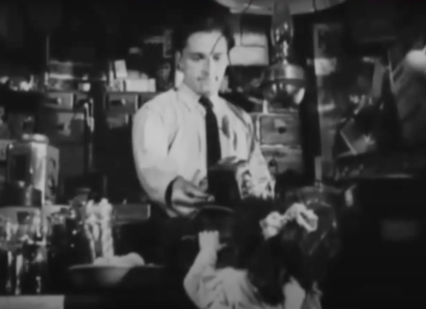
For many writers today, the film’s main reason for inclusion in any study of film history is that The Last Days of Dolwyn was Richard Burton’s screen debut, but the most fascinating aspect of the film in reality is how it foretold a controversial chapter in Welsh history. Emlyn Williams had been very keen to avoid portraying tensions between the Welsh and the English, as this had been one of his main aims with his stageplay, The Corn is Green. Undoubtedly aware of politically charged acts such as the burning of Penyberth bombing school in 1936 by Lewis Valentine, D. J. Williams and Saunders Lewis, and of the anger generated by the Westminster Government’s requisitioning of the Epynt and Preselau Mountains in the 1940s as training grounds for the armed forces, he chose to set his film in a period before his own birth in order to avoid contemporary tensions. He also chose to make the film’s villain a Welshman who has turned on his own people; as he explained in an interview: ‘I didn’t want it to be an English villain because . . . it would have looked like an attack on England, which I didn’t want’.
It can be safely assumed that Williams, raised in the Ceiriog Valley, had also witnessed the controversy over the Warrington Corporation plans in the early 1920s to drown the villages of Llanarmon, Tregeiriog and Pentre Bach. Whilst these plans ultimately failed, it seems that Williams’s memories of the events were triggered as he passed a lake in north Wales from which emerged a tower and the storyline for The Last Days of Dolwyn began to form in his mind. In all likelihood, it was Lake Vyrnwy, created in the 1880s when the village of Llanwddyn was drowned, that had inspired Williams.
However, he could not have foreseen that his chosen storyline would, a mere eight years later, in 1957, be re-enacted in real life when parliament approved the flooding of Cwm Tryweryn and the thriving community of Capel Celyn, just twenty miles from Rhydymain, in order to provide water for Liverpool and the Wirral. Emlyn Williams had attempted to distance his only foray into film scripting and directing from the reality of Wales in the forties and fifties, but reality had overtaken his vision by 1965 when the valley was drowned to create a reservoir.
Whilst filming in Rhydymain, and staying in Dolgellau, Hugh Griffith, a fervent Welsh nationalist, was invited by the town’s librarian, and later one of Wales’ foremost novelist and screenwriters, Marion Eames, to appear at a Plaid Cymru meeting. Griffith persuaded Burton to chaperone him and the pair, by all accounts, spent a stimulating evening at Dolgellau library discussing with the audience their love of Wales and their vision for the nation’s future. Neither would have given a moment’s thought to the likelihood that the film they were then filming would prophesise a galvanising moment in Welsh history that continues to reverberate in the national consciousness to this day.
Dr Gwenno Ffrancon is Director of Academi Hywel Teifi, the centre at Swansea University that promotes Welsh-language teaching and research and works to ensure a greater status for the language in all aspects of the university’s life and in south-west Wales. She is also an Associate Professor with an expertise in the film and cinema history of Wales.


